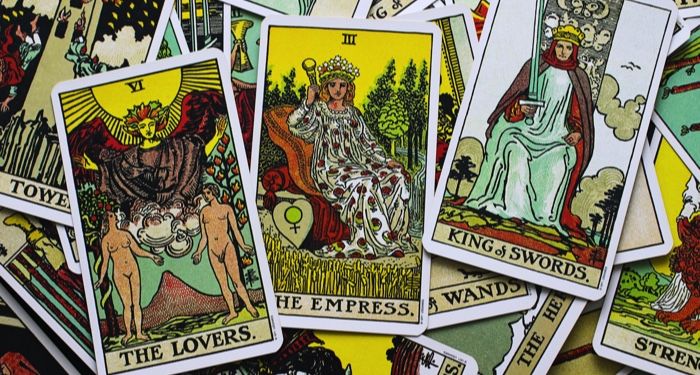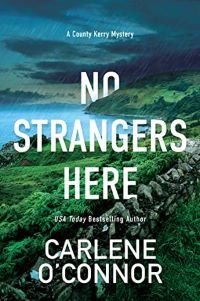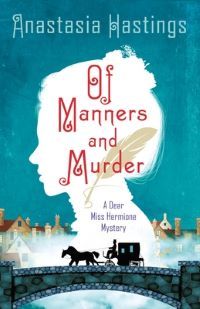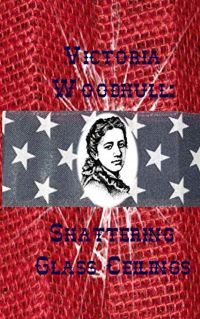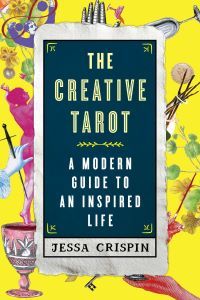During the pandemic, Carlene O’Connor, author of the Irish Village Mystery series, got a reading from her tarot teacher. He said that her next book was going to be different. O’Connor didn’t understand what he meant, since she was planning on writing another book in her cozy series.
But the next day at a meeting discussing her next work, her publicist pointed out that her darker cozies tended to do well, and her editor suggested doing something different. O’Connor said in an interview, “My jaw hit the floor. Then I got really excited about it because I had always wanted to branch out a little bit more as a writer.” That book became No Strangers Here (2022), the first in the County Terry Mysteries.
This story blew my mind. I have gotten much more interested in tarot cards in the last year, because of the imagery. Major Arcana cards showed up in drawings and paintings in contemporary art shows; some of my favorite artists had created their own decks. But learning that tarot cards could be used as part of the artistic process, whether it’s figuring out career steps or to help with character development, was something else entirely. I had the opportunity to talk to two authors who use tarot cards as part of their creative process.
A Few Definitions
Before we dive into the different ways writers use the cards in their work, here’s a brief word on a couple of definitions for tarot. Tarot cards are made of Major and Minor Arcana. Major Arcana can be archetypes, like the Fool, the Devil, and the World. There are usually 22 of them. Minor Arcana involve the Wands, Cups, Pentacles, and Swords, which are numbered and have face cards like a deck of playing cards.
People often talk about spreads in tarot cards. That means laying down a number of tarot cards in a certain way (like in a row, or in a cross formation). Each spot has a meaning, like the first card represents the past, second the present, third the future. There’s probably as many spreads as there are themed tarot cards!
Creating Worlds and Characters
Simply put, tarot cards can help you figure things out about your book, from the flaws of a character to the plot, or tone. Anything under the sun, practically. Anastasia Hastings, author of the recently published Of Manners and Murder, teaches these techniques to writers, explaining that it’s a brainstorming tool. Using the images of the tarot cards helps give ideas to help expand their work. (She also noted that she is not the first person to come up with this idea.)
For instance, Hastings was trying to figure out the flaws of her character. So when she pulled the Two of Swords, which in the Rider-Waite-Smith tarot deck (one of the most well known) shows a blindfolded woman, holding two swords, with her back to the water. Hastings explained, “traditionally in tarot, water stands for emotions. So you’re saying she doesn’t consider her emotions; she’s shut herself off from emotions, or she doesn’t recognize other people’s emotions. So we just use that card as sort of a jumping off point.” But tarot won’t write your plot for you, she noted.
Using Card Spreads
That’s only one of the many ways of using the cards. There are numerous spreads that writers can use, like a five-card spread that helps you figure out your character’s biggest strength, greatest weakness, etc. Or you can use a common tarot of three cards representing past, present, and future to help figure out the plot of a book. There’s a spread for any need; you can even make your own.
Of course, Hastings mentioned that one could use pictures that were cut out of a magazine for the same purpose, but it’s a lot cheaper to buy a tarot card and carry them around rather than buying a bunch of magazines and carrying them around. The fundamental process is the same, though: “You’re bound to get something that sparks an idea. That’s the whole point,” Hasting said.
Hastings recommended that you think beyond your genre with tarot cards. For instance, if you are writing a vampire book, there’s definitely vampire themed tarot cards on the market, but it might be better to try something that’s completely different, like a Gummy Bear tarot.
“How does that make you look at things differently? Because being a writer, you get one idea in your head and it’s hard to kick that idea out,” Hastings said, “if you’re thinking of it another way, and [you can] get it moving again, I think you can have a lot of fun with this.” And importantly, you really don’t have to be versed in tarot cards to use this method.
Setting the Mind Free
While tarot cards can help with the development of the book itself, they can also help uncover those connections lurking in the subconscious. Kelly Boyer Sagert, freelance writer and author of books like Victoria Woodhull: Shattering Glass Ceilings, uses tarot to help her with her research process. “One of the things I do is write about historical figures that were kind of lost to history,” Sagert said, “I’ll lay out three cards face down…I’ll pick one that feels like it resonates the most. I use it almost like a general trigger to my intuition about what to do next.”
For these kinds of stories, Sagert has to do a lot of research to find these people forgotten from history. Sagert explained that she might get a broken heart card for a 19th century bold feminist, and she’ll think “I always talk about how bold and controversial she feels. But did she have heartbreak when this happened? I use it to guide my intuition on these long forgotten people.”
She further explained, “I usually find out it’s backed up by research, but it’s not something I actually knew. Somehow, sometimes my intuition I think helps me to know what direction to look. Obviously when I’m writing an actual nonfiction novel about someone, I try to get information to verify it.”
Similar to Hasting’s approach, it helps her get out of ruts. “I’m stuck on researching all of a sudden, it’ll feel like I’ve got to [get a] flow of information again…It must give me permission to use my intuition to think about writing it a different way,” she said.
Not Just the Writing Process
As one can imagine, tarot can be used in so many different ways in the creative process. In Jessa Crispin’s The Creative Tarot: A Modern Guide to an Inspired Life, once she “notic[ed]the way the cards hook into your intuition and imagination, I realized that they could easily be used to assist in the creative process. When stuck on a piece, I’ll pull out some cards to find clarity, or I’d use them to figure out how to structure it.”
She explained that tarot could be used to restart projects, figure out how best to present a project to the world; and get out of a rut.
Crispin defines all the Major and Minor Arcana cards through a creative lens. For instance, the High Priestess card shows a seated woman holding the book. Generally, the card “presents wisdom, secrets, and ritual,” explained Crispin. For Crispin, she defines the card as a reminder that artists need to keep learning; nothing is made in a vacuum. She wrote, “When the High Priestess shows up in a reading, it can indicate a need for you to put aside the work for a moment and make time for study.”
There are other tarot books for writers and other creators out there. That’s one of the best parts of tarot cards: there are so many ways to use the cards. If you are a writer or any type of creator, consider using tarot cards to help you in the process. You never know what the cards will reveal!
For a discussion of tarot cards used in books, check out my piece Beyond Reading the Cards: The Use of Tarot in Fiction. For a special reader’s spread, check out Sarah S. Davis’s article!

